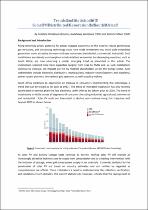JavaScript is disabled for your browser. Some features of this site may not work without it.
- ResearchSpace
- →
- Research Publications/Outputs
- →
- Book Chapters
- →
- View Item
| dc.contributor.author |
Pandarum, Aradhna

|
|
| dc.contributor.author |
Lekoloane, Gaoshitwe A

|
|
| dc.contributor.author |
Milazi, Dominic BK

|
|
| dc.date.accessioned | 2019-07-17T09:42:40Z | |
| dc.date.available | 2019-07-17T09:42:40Z | |
| dc.date.issued | 2019-01 | |
| dc.identifier.citation | Pandarum, A., Lekoloane, G.A. and Milazi, D.B.K. 2019. Trends and statistics of Solar PV distributed generation in South Africa. In: The Sustainability Energy Resource Handbook. South Africa Volume 9: The Essential Guide, pp. 19-25 | en_US |
| dc.identifier.isbn | 978-0-620-45240 | |
| dc.identifier.uri | https://issuu.com/alive2green/docs/energy_9__web_ | |
| dc.identifier.uri | http://hdl.handle.net/10204/11033 | |
| dc.description | Chapter published in The Sustainability Energy Resource Handbook. South Africa Volume 9: The Essential Guide | en_US |
| dc.description.abstract | Rising electricity prices, potential for power outages awareness on the need to reduce greenhouse gas emissions, and decreasing technology costs have made investment into small scale embedded generation more attractive to many end-user consumers (residential, commercial, Industrial). Such installations are already commonplace in industrialised economies but developing countries, such as South Africa, are now observing a similar emerging trend as presented in this article. The installations reported here have capacities ranging from 1kW to 5MW and, as such installations continue to increase, the impacts are felt by multiple stakeholders across the energy sector. Such stakeholders include electricity distributors, municipalities, industry (manufacturers and installers), power system planners, the national grid operator, as well as policy-makers. South Africa continues to experience an increase in consumers implementing this technology; a trend that can be traced as far back as 19921. The trend of increased installation has only recently accelerated in earnest given the low electricity tariffs offered by Eskom prior to 2010. The trend in installations is visible across all segments of consumers including industrial, agricultural, commercial and residential. Solar PV costs are forecasted to decline and continue along this trajectory well beyond 2020 as shown below. | en_US |
| dc.language.iso | en | en_US |
| dc.publisher | Alive2Green | en_US |
| dc.relation.ispartofseries | Worklist;21946 | |
| dc.subject | Solar PV | en_US |
| dc.title | Trends and statistics of Solar PV distributed generation in South Africa | en_US |
| dc.type | Book Chapter | en_US |
| dc.identifier.apacitation | Pandarum, A., Lekoloane, G. A., & Milazi, D. B. (2019). Trends and statistics of Solar PV distributed generation in South Africa., <i>Worklist;21946</i> Alive2Green. http://hdl.handle.net/10204/11033 | en_ZA |
| dc.identifier.chicagocitation | Pandarum, A, Gaoshitwe A Lekoloane, and Dominic BK Milazi. "Trends and statistics of Solar PV distributed generation in South Africa" In <i>WORKLIST;21946</i>, n.p.: Alive2Green. 2019. http://hdl.handle.net/10204/11033. | en_ZA |
| dc.identifier.vancouvercitation | Pandarum A, Lekoloane GA, Milazi DB. Trends and statistics of Solar PV distributed generation in South Africa.. Worklist;21946. [place unknown]: Alive2Green; 2019. [cited yyyy month dd]. http://hdl.handle.net/10204/11033. | en_ZA |
| dc.identifier.ris | TY - Book Chapter AU - Pandarum, A AU - Lekoloane, Gaoshitwe A AU - Milazi, Dominic BK AB - Rising electricity prices, potential for power outages awareness on the need to reduce greenhouse gas emissions, and decreasing technology costs have made investment into small scale embedded generation more attractive to many end-user consumers (residential, commercial, Industrial). Such installations are already commonplace in industrialised economies but developing countries, such as South Africa, are now observing a similar emerging trend as presented in this article. The installations reported here have capacities ranging from 1kW to 5MW and, as such installations continue to increase, the impacts are felt by multiple stakeholders across the energy sector. Such stakeholders include electricity distributors, municipalities, industry (manufacturers and installers), power system planners, the national grid operator, as well as policy-makers. South Africa continues to experience an increase in consumers implementing this technology; a trend that can be traced as far back as 19921. The trend of increased installation has only recently accelerated in earnest given the low electricity tariffs offered by Eskom prior to 2010. The trend in installations is visible across all segments of consumers including industrial, agricultural, commercial and residential. Solar PV costs are forecasted to decline and continue along this trajectory well beyond 2020 as shown below. DA - 2019-01 DB - ResearchSpace DP - CSIR KW - Solar PV LK - https://researchspace.csir.co.za PY - 2019 SM - 978-0-620-45240 T1 - Trends and statistics of Solar PV distributed generation in South Africa TI - Trends and statistics of Solar PV distributed generation in South Africa UR - http://hdl.handle.net/10204/11033 ER - | en_ZA |






